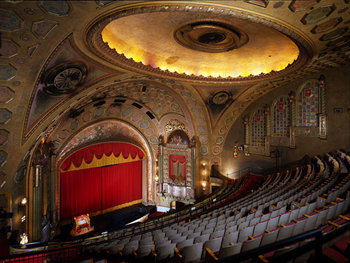Alabama Theatre
The Alabama Theatre, is a 2,500 seat "movie palace" opened by Paramount Studios in 1927 at 1817 3rd Avenue North in downtown Birmingham's "Theater District. Originally constructed to show silent films, the Alabama features a Wurlitzer theatre organ. Now painstakingly restored, the Alabama is operated by Birmingham Landmarks, a non-profit corporation headed by organist Cecil Whitmire. The Alabama hosts numerous live concerts and classic movie screenings, as well as weddings and private events throughout the year.
History
Construction plans for the Alabama were announced in 1926, but ground breaking was delayed until April 1, 1927. The grand opening was held as originally scheduled on December 26, 1927. Construction of the concrete and steel building cost approximately $1.5 million.
In 1934, the Loveman's department store next door burned to the ground. Thanks to a thick firewall on that side of the Alabama, the theatre was unharmed aside from some smoke damage around air vents in the auditorium. (These smoke stains would remain until the 1998 theatre restoration.)
One of the things the Alabama was known for in its early days was its Mickey Mouse Club, which was formed in 1933. Meetings were held every Saturday, where the children would perform for each other, watch Mickey Mouse cartoons, and participate in other activities. The Club also sponsored food and toy drives for the underprivileged. By 1935, the Club had over 7,000 members, making it the biggest Mickey Mouse Club in the world. Membership eventually peaked at over 18,000 before the Club closed almost ten years after it was formed.
Another regular event at the Alabama was the Miss Alabama Pageant. From 1935 to 1948, the rules of the Miss America Pageant allowed multiple contestants per state. The Alabama Theatre hosted the Miss Birmingham Pageant in those years. When the rules were changed in 1949, the Alabama became host to the Miss Alabama Pageant and continued to do so through 1966.
The decline of downtown Birmingham through the 1960's and 1970's saw the closing of most of the downtown's movie theatres. In 1981, Plitt Theatres of Chicago closed the Alabama and sold it to Cobb Theatres of Birmingham. Cobb attempted to reopen the Alabama several times, but was unsuccessful. Cobb eventually sold the Alabama to Costa and Head, developers working to revitalize the downtown area. Costa and Head initiated series of classic movies at the Alabama with some success, but ultimately filed for bankruptcy in 1986.
The Alabama Chapter of the American Theatre Organ Society (ATOS) had been maintaining the Alabama's organ since in the 1970's. They sought permission to remove the organ from the Alabama to save it, but Costa and Head's creditors deemed it the single most valuable item in the building and forbid its removal. In response the Alabama Chapter of ATOS began a fund-raising effort to buy the Alabama. The effort was successful and in 1987 Birmingham Landmarks, Inc. was formed to buy and manage the Alabama. With the purchase, the theatre was renamed the Alabama Theatre for the Performing Arts.
In 1993 the Alabama Theatre was designated the "official state historic theatre" by the Alabama legislature. [1] In 1998, the Alabama underwent a complete restoration in which gold leaf and other paint was cleaned or replaced, seats were replaced or recovered, and some carpet and drapes were replaced.
Birmingham Landmarks continues to operate the Alabama today, and has also purchased the Lyric Theatre, a 1914 vaudeville theatre located across the street from the Alabama.
Theatre Organ
When the Alabama Theatre was built in 1927, films were silent and required a musical accompaniment. This was typically provided by an orchestra or theatre pipe organ. The Alabama's organ is a Crawford Special-Publix One Mighty Wurlitzer. Only 25 of this model of organ were built and the Alabama's is one of only three still installed in their original sites.
Nicknamed Big Bertha, the Alabama's organ is a four-manual (keyboard) organ. It was originally installed with 20 ranks (sets of pipes), but has been expanded to 28. It also features numerous percussion instruments and sound effects to accompany silent movies.
Trivia
- The Alabama Theatre was the first public building in Alabama to have air-conditioning. (Whitmire & Hanks 2002).
References
- "Alabama Theatre." Wikipedia, The Free Encyclopedia. 27 Apr 2006, 13:54 UTC. 27 Apr 2006, 14:22 [2].
- Whitmire, Cecil and Jeannie Hanks. (2002) The Alabama Theatre: Showplace of the South, Birmingham Landmarks. ISBN 0310975124
External links
- Alabama Theatre website
- Alabama Theatre photographs and clippings at the Birmingham Public Library archives.
- Alabama Theatre photographs and drawings at the Historic American Buildings Survey.
